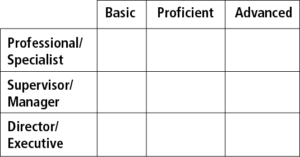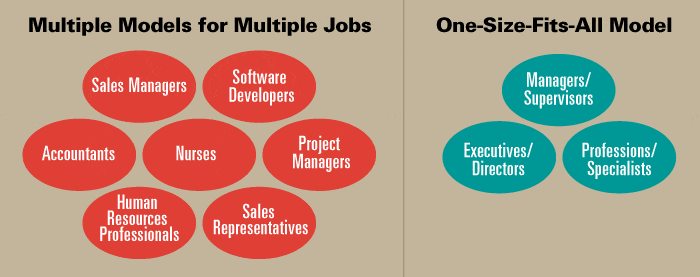When planning a competency model-building project, three distinctive types of models need to be considered:
- Single Job Competency Model
- One-Size-Fits-All Model
- Multiple Jobs Models
A project usually focuses on one of these approaches, although it is possible to use a combination of approaches within one organization. The following is an overview and summary of the three types. Links to full descriptions are provided at the end of each section.
-
SINGLE JOB COMPETENCY MODEL
- Used for an important, focused set of jobs, e.g.,
- Sales Rep, Project Manager, Customer Service Rep
- Requires rigorous data collection, including:
- Resource panel
- Key Event Interviews
- Data from Other Sources
- The completed model can aid development of training materials
Typical Features
- Highly specific behavioral descriptors that describe what superior performers do in specific tasks and situations and with whom
- Detailed linking of competencies to job responsibilities and specific tasks
When to Use
- Opportunity to gain competitive advantage by improving productivity of people in a key job through selection or training
- Potential productivity gains justify time and expense of this approach
- Need to use model as basis for a training curriculum
- There are several superior performers in the job now
- Job is expected to continue for at least 3 years
Example: Project Manager job
-
ONE-SIZE-FITS-ALL MODEL
- Targets a broad set of jobs (e.g., all managerial jobs)
- Model often includes competencies selected for alignment with company’s values and strategic direction
- Competencies and behaviors are described in general terms that are not job specific
When to Use
- When line management or HR wants to promote alignment with vision, values, and strategy
- When simple solutions are preferred
- When HR wants to quickly implement something that will have broad impact
- When a training and development program based on the competency model will serve a large group (e.g., mid-level managers)
- Identifies a set of “building block” competencies for constructing all job models
- Each competency model uses some of the building block competencies
- Often includes technical skills and knowledge
- Often uses competency levels
- Competency models may include:
- A core set of competencies for all employees
- A set of competencies for everyone in a job family (e.g., Finance)
- A set of job-specific competencies
- Competency models are large (16 or more competencies)
Why have Competency Levels
- Levels facilitate comparison of jobs —
A competency may be required at a basic level in one job and at an advanced level in another
- Levels facilitate assessment of individuals as part of performance appraisal/management
- Levels allow comparison of individual profiles with job profiles (e.g., for internal selection)
When to Use the Multiple Jobs Approach
- When competency models are desired for many jobs in one organizational unit
- When technical skill and knowledge are important
- When the jobs in an organization are highly varied, and different sets of competencies are required for different jobs
- When there is a need to match individual skill sets to assignments, for selection, career planning and succession planning
- When technology or HR software is available
Blog: Advantages of One-Size-Fits-All and Multiple Jobs Approaches
THE BOTTOM-LINE ABOUT COMPETENCY MODELS
Planning the development of competency models is an exercise in practical problem solving. There are alternative methods for collecting and analyzing data, for deciding what to include in the model, and for formatting the model and its behavioral descriptors. The choices among the alternatives should depend on goals of key stakeholders, the needs of key users, the budget and time available to develop the model, and the preferred styles of the model building team.
What makes a good competency model? The model must meet the needs of its key users. Each competency should be conceptually coherent and different from the other competencies. The behavioral descriptors should be clearly and crisply worded. The model should also be parsimonious; including too many competencies and behavioral descriptors makes a model ponderous to read and use. Finally, a good model is often supplemented with components that will add value for an intended HR application.
Contact Workitect if you want help in building competency models for your organization, or attend our Building Competency Models workshop and learn how to model your own models.
 To learn more about our products and services, and how competencies and competency models can help your organization, call 800-870-9490, email edward.cripe@workitect.com
To learn more about our products and services, and how competencies and competency models can help your organization, call 800-870-9490, email edward.cripe@workitect.com
or use the contact form at Workitect.
©️2024, Workitect, Inc.



Leave A Comment